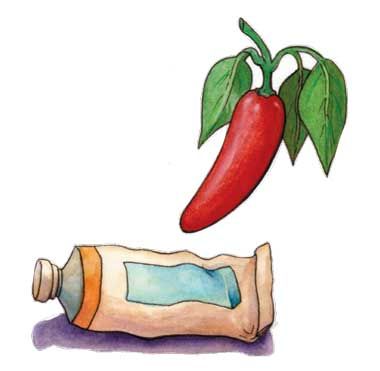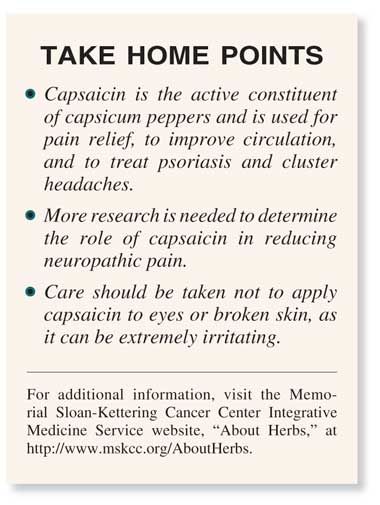Capsaicin
Capsaicin, the active component derived from the fruit of capsicum, is used to relieve pain, to improve circulation, to treat cluster headaches and psoriasis, and for weight loss. Capsicum or cayenne pepper, a shrub prevalent in many tropical and subtropical climates, is an important ingredient of many cuisines around the world. It has been used in traditional medical systems as a remedy for digestive and circulatory problems, poor appetite, and to relieve muscle and arthritic pain. Capsaicin is currently available in capsule form and as an ingredient in topical creams.
Capsaicin
Capsaicin, the principal ingredient of chilli peppers, has powerful pain-relieving properties. It acts as a counterirritant and functions by reducing the levels of substance P, a neurotransmitter that conveys pain signals to the brain.
Evidence from clinical trials suggests the benefits of capsaicin for psoriasis, cluster headaches, and rhinitis. However, limited data are available to assess its potential in relieving arthritic and neuropathic pain. More research is warranted.
The use of gloves is recommended for topical application. Because capsaicin can cause serious irritation, it should not be applied to broken skin, mucous membranes, or the eyes.
-Barrie Cassileth, phd
SUMMARY: Capsaicin, the active component derived

from the fruit of capsicum, is used to relieve pain, to improve circulation, to treat cluster headaches and psoriasis, and for weight loss. Capsicum or cayenne pepper, a shrub prevalent in many tropical and subtropical climates, is an important ingredient of many cuisines around the world. It has been used in traditional medical systems as a remedy for digestive and circulatory problems, poor appetite, and to relieve muscle and arthritic pain. Capsaicin is currently available in capsule form and as an ingredient in topical creams.
Capsaicin is thought to reduce pain sensation by temporarily depleting a neurotransmitter, substance P, which relays pain signals to the brain.
Studies support the benefits of topical capsaicin for psoriasis,[1] and of intranasal application for rhinitis[2] and cluster headaches.[3]
Data also suggest that capsaicin cream can effectively control postsurgical pain in cancer patients.[4] Its utility for arthritic pain remains inconclusive.[5,6]
A review of studies of capsaicin for neuropathic pain associated with HIV, diabetes, mastectomy, and postherpetic neuralgia concluded that available data are too limited to enable full assessment of its benefits, and that additional well-designed clinical trials are required.[7]
Originally thought by some to be a carcinogen,

capsaicin was shown to be safe in animal studies.[8] Interestingly, it demonstrated chemopreventive properties,[9] but this has not been verified in human studies.
ADVERSE REACTIONS: Common (topical): Burning, urticaria, contact dermatitis.[10]
HERB-DRUG INTERACTIONS: Capsaicin preparations may interact with the following:
ACE inhibitors: Capsaicin can increase the incidence of cough associated with ACE inhibitors.
Sedatives: Capsaicin may increase sedation.
Theophylline: Concurrent administration with capsaicin may increase absorption.
Antihypertensives: Capsaicin may affect the action of antihypertensive medications.[11]
References:
REFERENCES
1. Ellis CN, Berberian B, Sulica VI, et al: A double-blind evaluation of topical capsaicin in pruritic psoriasis. J Am Acad Dermatol 29:438-442, 1993.
2. Van Rijswijk JB, Boeke EL, Keizer JM, et al: Intranasal capsaicin reduces nasal hyperreactivity in idiopathic rhinitis: A double-blind randomized application regimen study. Allergy 58:754-761, 2003.
3. Fusco BM, Marabini S, Maggi CA, et al: Preventative effect of repeated nasal applications of capsaicin in cluster headache. Pain 59:321-325, 1994.
4. Ellison N, Loprinzi CL, Kugler J, et al: Phase III placebo-controlled trial of capsaicin cream in the management of surgical neuropathic pain in cancer patients. J Clin Oncol 15:2974-2980, 1997.
5. McCarthy GM, McCarty DJ: Effect of topical capsaicin in the therapy of painful osteoarthritis of the hands. J Rheumatol 19:604-607, 1992.
6. Deal CL, Schnitzer TJ, Lipstein E, et al: Treatment of arthritis with topical capsaicin: A double-blind trial. Clin Ther 13:383-395, 1991.
7. Derry S, Lloyd R, Moore RA, et al: Topical capsaicin for chronic neuropathic pain in adults. Cochrane Database Syst Rev (4):CD007393, 2009.
8. Park KK, Chun KS, Yook JI, et al: Lack of tumor promoting activity of capsaicin, a principal pungent ingredient of red pepper, in mouse skin carcinogenesis. Anticancer Res 18:4201-4205, 1998.
9. Oyagbemi AA, Saba AB, Azeez OI: Capsaicin: A novel chemopreventive molecule and its underlying molecular mechanisms of action. Indian J Cancer 47:53-58, 2010.
10. Newall CA, Anderson LA, Phillipson JD, et al: Herbal Medicines: A Guide for Health Care Professionals. London, Pharmaceutical Press, 1996.
11. Brinker F: Herb Contraindications and Drug Interactions, 2nd ed. Sandy, Oregon; Eclectic Med Publications; 1998.
Newsletter
Stay up to date on recent advances in the multidisciplinary approach to cancer.